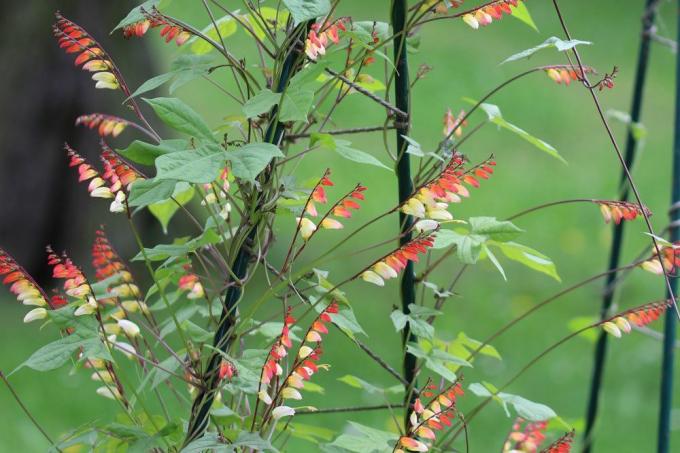
table of contents
- care
- Location
- floor
- plants
- to water
- Fertilize
- Cut
- Overwinter
- Multiply
- Diseases
Profile and care information open +conclude -
- Flower color
- yellow, orange, red, white
- Location
- Sunny, full sun
- Heyday
- July August September
- Growth habit
- upright, bushy, annual, climber, perennial, overhanging
- height
- up to 500 centimeters high
- Soil type
- sandy, gritty
- Soil moisture
- moderately moist, fresh
- PH value
- neutral, weakly alkaline
- Limescale tolerance
- Calcium tolerant
- humus
- rich in humus
- Poisonous
- Yes
- Plant families
- Morning glory, Convolvulaceae
- Plant species
- Climbing plants, Balcony plants, ornamental plants
- Garden style
- Flower garden, terrace garden, ornamental garden
The star bindweed, botanically called Ipomoea lobata, is one of the popular climbing plants with beautiful umbels. The flowers open one after the other with a play of colors from red to yellow-orange to a bright white. This peculiarity has given the creeper the name of the Spanish flag. The English name "Morning Glory" describes the magnificence the gardener can expect. Unfortunately, the star winds are not hardy and therefore not suitable for year-round outdoor cultivation.
care
An Ipomoea lobata doesn't need a lot of maintenance. In addition to regular watering and fertilization, it is especially important that the shoots grow into trellises from time to time be guided so that the meter-long loop drives can wind around the support and provide sufficient support Find.
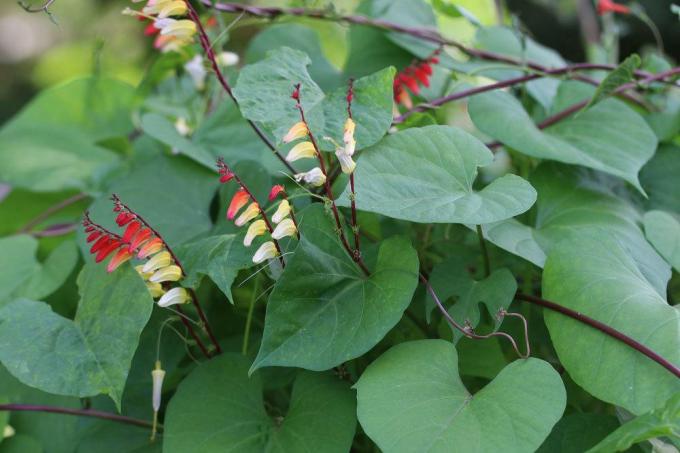
Location
The right location is one of the most important factors for a plant to grow and thrive healthily. This should be modeled as closely as possible to the natural conditions so that the Ipomoea lobata feels comfortable and can develop its full splendor. Star winds love a sunny and warm location, which is why southern locations are the perfect choice for the climber.
- Light requirement: sunny
- at least 5 hours of sun a day
- also tolerates the midday sun
- as warm as possible
- heat tolerant
- Protected from strong winds and heavy rain
- not tolerated by frost
- suitable for trellises, pergolas and rose arches
- as a privacy screen and greening of balconies and terraces
The Spanish flag is a bit sensitive to wetness, strong winds and cool temperatures. Therefore, it should be planted as protected as possible. A light roofing, for example on a balcony or on a pergola, is ideal.
floor
The star winds prefer a moderately nutritious, medium-heavy soil, which should be neutral or slightly alkaline, i.e. calcareous. The substrate should both drain and store the water well. You can do this in very sandy soils by mixing in a good portion of humus-rich potting soil or ripe compost. Very heavy garden soils are made more permeable with sand or grit.
- moist, fresh, normal garden soil
- moderately nutritious
- rather slightly damp
- pH value: neutral to slightly alkaline
- lime tolerant
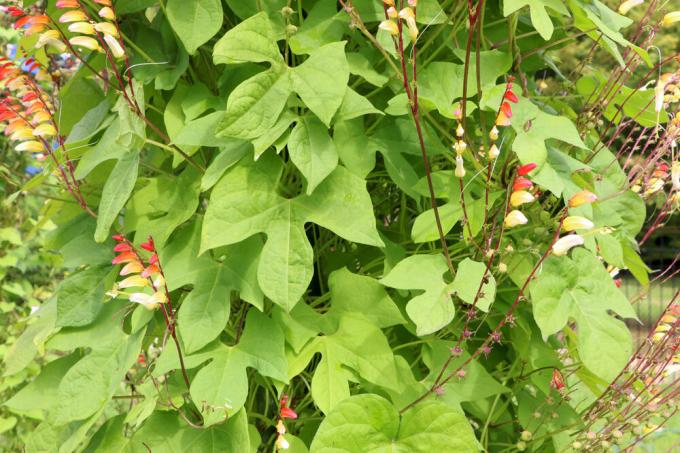
If the soil is prone to standing moisture, either a thick drainage layer should be built in before the Spanish flag is planted or the climbing plant should be cultivated in a tub.
particularities
Star winds are perennial plants, which we usually cultivate as an annual. Already in the first year, after rapid and dense shoot and leaf growth, the first panicles of flowers develop from the end of June or the beginning of July, which can be up to 40 cm long. While the buds at the tip of these panicles are deep red, the flowers change their color from a strong yellow-orange to a bright white when opened. Since several of these ripening states are always present on a panicle, each individual umbel is colored in different color transitions. The plant grows and blooms tirelessly until the first frosts. Unfortunately, since it cannot tolerate cold temperatures, the Spanish flag dies before winter. In Central America, where warm temperatures prevail all year round, the plant is perennial.
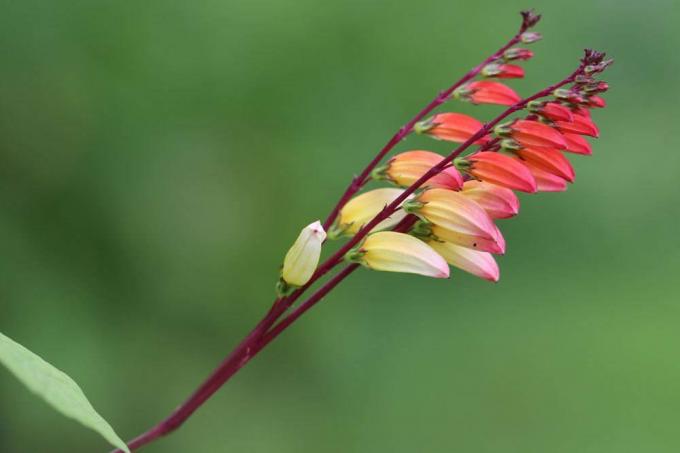
sowing
As a rule, garden winds are not available as pre-grown plants, but as seeds in specialist shops. Because of the lack of winter hardiness, the Ipomoea lobata is cultivated here as an annual plant. That is why it is necessary to sow seeds every spring. Sowing is not particularly difficult.
The creeper is sown from March to April in an unheated greenhouse or a cold frame. Alternatively, the star winds can of course also be pulled up on the windowsill or sown directly outdoors from mid-May. However, it is important that the plant has sufficient amounts of light available after germination. All that is required for sowing and preculturing in the house is a small flower pot, a room greenhouse or a planter and some sterile and nutrient-poor substrate. To make germination easier, you should soak the seeds in room-temperature water overnight, or better for 24 hours.
- Time: March / April
- in the greenhouse, a cold frame or on the windowsill in the house
- Place in a moist substrate
- Substrate: cactus soil, seed soil
- Place 3 to 4 seeds in a pot
- Cover with 0.5 cm of fine earth or sand (dark germs)
- cover with glass pane
- alternatively, put on freezer bags
- Temperature: 15 to 20 degrees
- set up brightly (without direct sun)
- Germination time: 10 to 14 days

After germination, the small plants from a size of at least three centimeters are pricked into individual pots and a stick is made available to them as a climbing aid
plants
From mid-May, when late frosts are no longer to be feared, the Ipomoea lobata can be planted outdoors. If the ornamental plant is to be used as a privacy screen, it is planted at a distance of about 80 cm.
- Plant at a slight angle to the trellis
- possibly create a drainage
- Planting depth: as before
It has been tried and tested to cover the soil around the plant with organic material so that weed growth can be contained and the soil moisture can be better retained. The Spanish flag, like other sun-loving plants like Roses - no bark mulch. Only plant species whose natural location is in partial shade or shade like natural ground cover such as leaves that fall from the trees in autumn. Leaves and bark usually lower the pH in the soil (make it more acidic) and prevent good air circulation in the soil. Therefore, to cover the soil in star winds, it is better to use bark compost and leave out the narrower root area.
Climbing aid
The star winch needs a climbing aid so that it can wind its shoots up to several meters long. A pergola, a scaffold, a fence or a railing are suitable for this. You should lead the tendrils to the trellis right from the start. In good locations, the climbing plant can reach heights of up to five meters. As a rule, however, it does not exceed two to three meters by autumn.
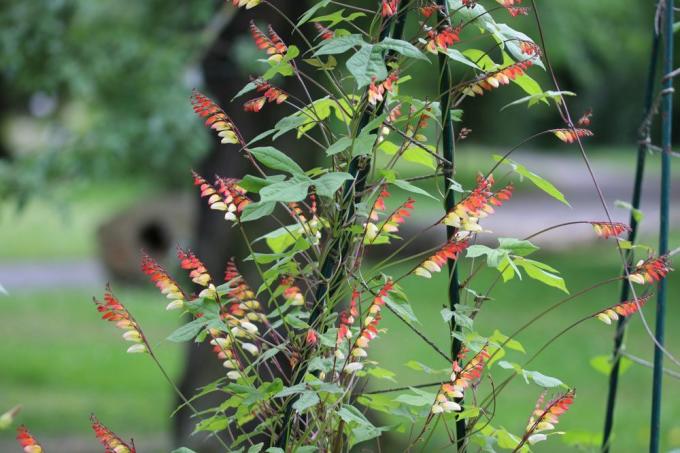
Privacy screen
Many gardeners know the following problem: In some places on the property or on a balcony, especially around a seat, a nice privacy screen is still missing. However, it shouldn't take up too much space. And it should also protect it from uninvited looks as quickly as possible. The solution is simple, because fast-growing climbing plants such as the star winds grow into a dense privacy screen within a very short time.
Bucket culture
A bucket culture on the balcony or terrace is also possible. In this case, care must be taken to select a particularly large pot. Since the stellar winds grow very quickly and become at least two to three meters high within one growing season, a heavy planter is important to give the plant stability.
- must contain drainage holes in the floor
- preferably made of stone or clay (stability)
- At least 60 to 80 cm in diameter
- flat coaster
- fill in a thick drainage layer
- Substrate: Mixture of potting soil and sand, compost-rich garden soil
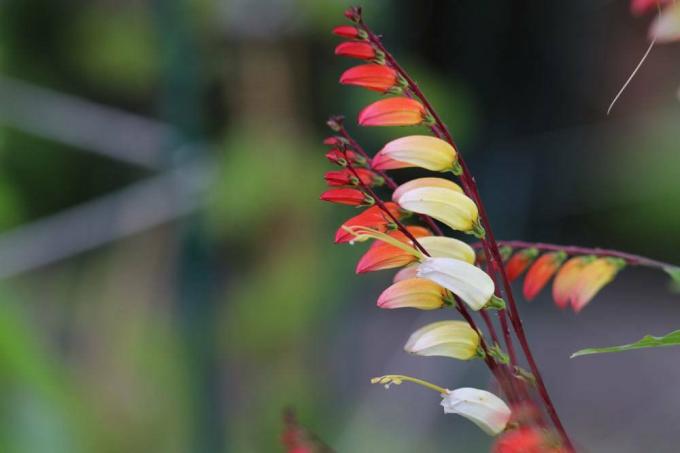
to water
The stellar winds should only be watered moderately during the growing season. The root ball should never dry out completely. Waterlogging and persistent drought mean the certain death of the climbing plant. It is best to do a finger test before watering again. If the upper layer of soil already feels dry, pour lightly. During periods of great heat, the plant consumes a lot of water and may have to be watered twice a day.
Fertilize
In order to be able to form stable, healthy shoots and a multitude of breathtaking flower umbels, the star bindweed needs sufficient amounts of nutrients. However, it is essential to avoid high levels of nitrogen, as otherwise the climbing plant will produce more leaf mass than flowers. It is best to mix ripe compost or a handful of horn shavings or horn meal under the garden soil when planting. Potted plants get along better with a slow release fertilizer, but can also be fertilized with liquid fertilizer over the irrigation water every two weeks. Fertilizers with a high concentration of potassium promote the flowering of the star winds and contribute to a luminous abundance of flowers.
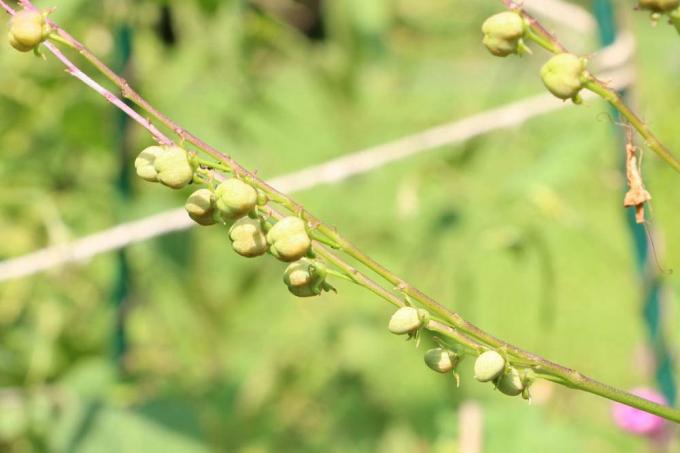
Cut
The stellar winds grow very quickly and vigorously. In just one year, the shoots can reach a length of two to three meters. Nevertheless, it basically does not need pruning. If it becomes too lush in its location, it can be cut back to the desired height with garden shears or rose shears or entire shoots can be cut at the base. If you want to overwinter the Indian feather, you only cut it back moderately in autumn. It is then severely shortened before the new season in late winter or spring, as it becomes too lush without pruning and is difficult to handle.
- only prune to keep growth in check
- Remove bare or diseased shoots at the roots
- Shorten slightly before wintering
Toxicity
All bindweed, except for the sweet potato and the Ipomoea aquatica, contain alkaloids in all parts of the plant and are therefore poisonous. These so-called lysergic acid amides are substances from the group of ergot alkaloids. They have a strong hallucinogenic effect. Although these toxins do not occur in the same high concentration in all types of wind, they should nonetheless In the face of missing or contradicting research results, gardeners also exercise caution with the stellar winds permit. The concentration of these psychedelic substances has been shown to be particularly high in the seed pods, so it is better to wear gloves when harvesting and sowing. The plant is of course also poisonous for children and Pets, but only when consumed. Skin contact with the leaves is usually harmless.
Overwinter
Since the Spanish flag is not hardy and is therefore grown here as an annual plant, it can be used in autumn, when it begins to wither and wither after the first cool temperatures, simply pulled out and composted will. If you decide to cultivate the creeper for several years, the Ipomoea lobata im September, when the outside temperatures drop below 10 degrees, must be brought to their winter quarters. The first frost damage can occur from around 5 degrees. Since the plant does not lose its leaves in winter, it must be overwintered in light. In slightly cooler temperatures, the metabolism of the creeper slows down considerably, so that it usually only grows very little, if at all, over the winter months.

- dispose of them in autumn if they are one year old
- perennial culture: put in winter quarters in September
- Cut back so much that it can be transported without any problems
- Temperature: 10 to 15 degrees
- set up very bright
- heated greenhouse
- cool winter garden
In winter quarters, the plant is only watered enough that the root ball does not dry out completely. The fertilization is completely stopped. In late winter or early spring, the plant is then cut back heavily and possibly transplanted into a slightly larger pot. From mid-May, slowly get used to the changed temperature and light conditions in the open air during the day from the middle of May. If it gets cold again at night, she has to go back into the house. Place the plant in the shade for the first few days or cover it with a light fleece, otherwise the leaves can be burned from the sun's rays.
Multiply
Increasing stellar winds is not difficult. In practice, reproduction occurs almost without exception via the seeds. These are available from specialist retailers everywhere. The nomenclature of the star winds is not always uniformly regulated in seed catalogs. It is listed under Ipomoea lobata as well as under the synonyms Mina lobata and Quamoclit lobata.
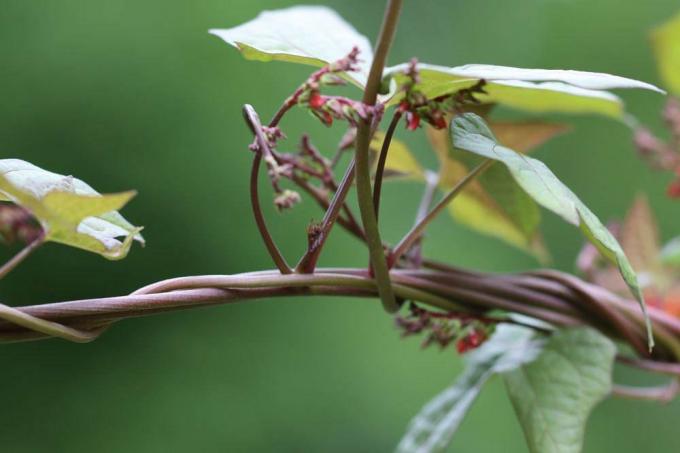
Diseases
In a good location, the stellar winds rarely get sick. In extreme weather conditions or too much or too little moisture or an unsuitable place in the garden, the otherwise robust plant becomes more susceptible.
Kinking of the seedlings
It happens again and again that young seedlings suddenly snap off overnight despite the climbing rod. In most cases, a fungus that kills the plants is to blame. Therefore, it is essential to use a germ-free substrate for sowing. Heating the substrate for a few minutes in the microwave also kills germs. However, if the fungus sits on the seed, the sterile substrate does not help either. That is why it is important to buy high quality seeds.
Spider mites
The climbing plant is particularly susceptible to spider mites or aphids when cultivated under glass and in winter quarters. As a rule, however, it is sufficient to provide a little better ventilation and cut off the infected shoots.
